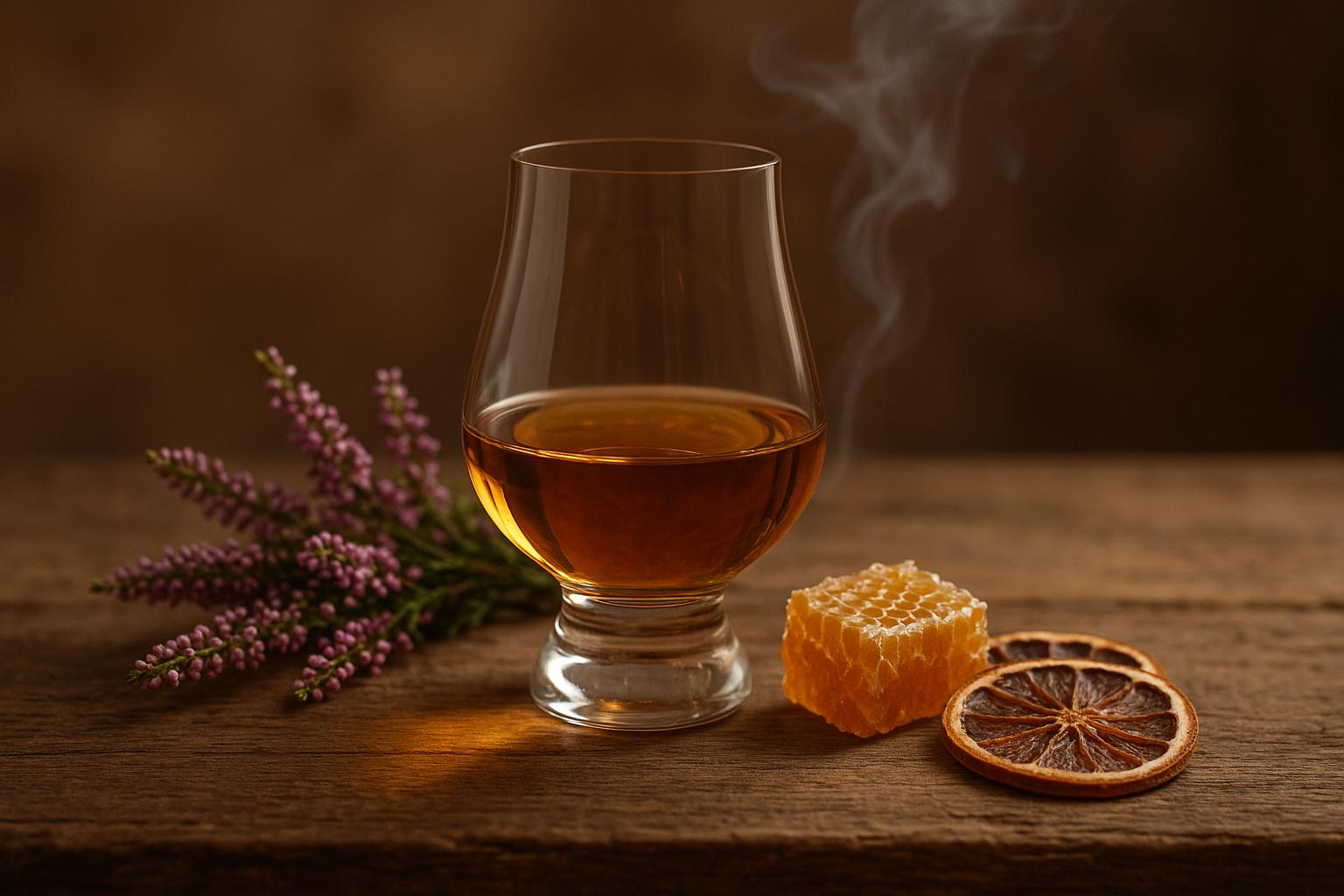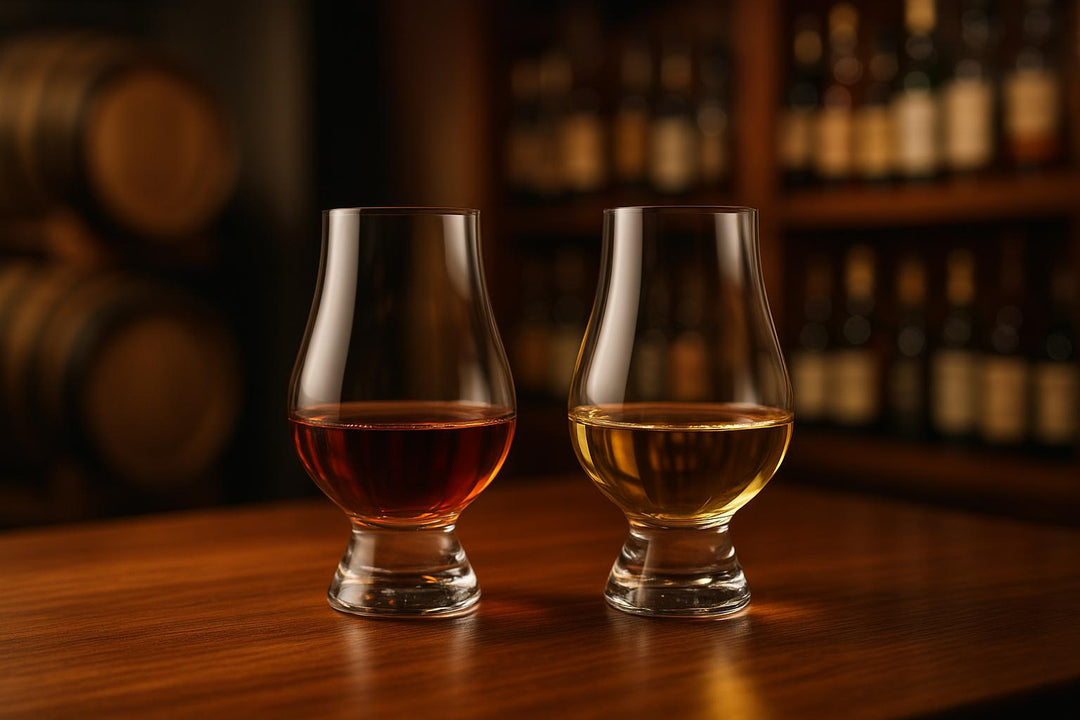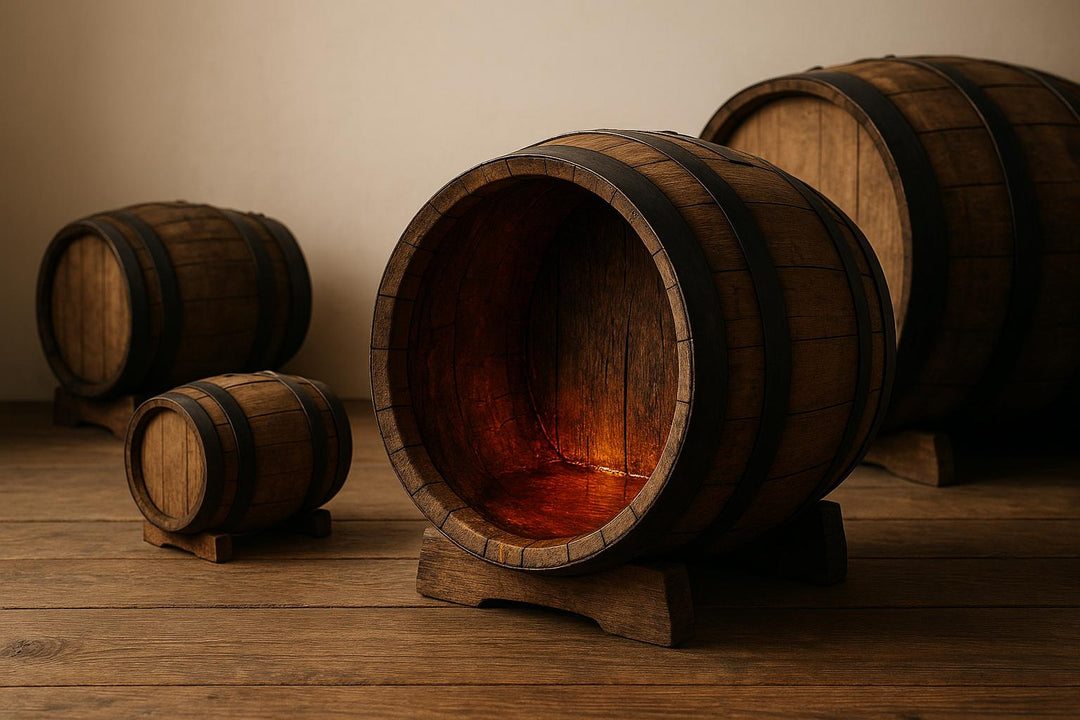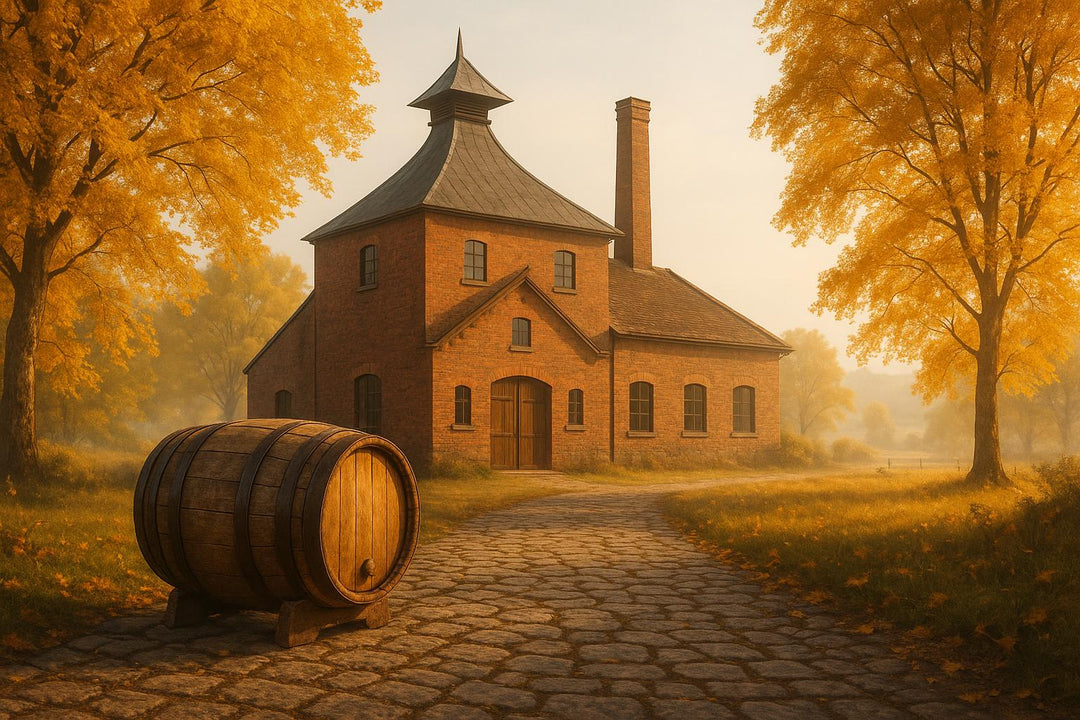Highland whisky is Scotland's most diverse whisky region, offering a wide range of flavours influenced by its geography and microclimates. Here's what you need to know:
- Light & Floral: Soft, delicate whiskies with herbal and floral notes. Best for beginners or as an aperitif.
- Fruity & Full-Bodied: Bold, sweet whiskies with orchard and stone fruit flavours. Ideal for intermediate drinkers.
- Rich & Oaky: Deep, warming whiskies with vanilla, caramel, and dried fruit notes. Perfect for seasoned whisky lovers.
- Peaty & Smoky: Whiskies with earthy, smoky characteristics, balanced by sweet or spicy undertones. Suited for adventurous palates.
Each style is shaped by the Highlands' varied landscapes, cooler climate, and precise production techniques, including cask selection and still design. Whether you're new to whisky or a seasoned enthusiast, Highland whiskies offer something for every taste.
1. Light and Floral
The light and floral style of Highland whisky highlights the softer, more delicate side of Scotland's most diverse whisky region. These whiskies offer a subtle complexity that appeals to both beginners and seasoned enthusiasts, showcasing floral and herbal undertones that are both inviting and intriguing.
Flavour Characteristics
This style reflects the Highlands' rich heritage, delivering a nuanced flavour profile. Expect notes of heather, wildflowers, and gentle spices that create a balanced and elegant experience. While the floral foundation takes centre stage, hints of smoke and spice add depth without overpowering the palate.
The herbaceous and wildflower notes echo the natural beauty of the Highland landscape. As the whisky lingers, layers of complexity unfold, sometimes revealing a whisper of smoke that enhances its character.
Notable Distilleries
Several distilleries are celebrated for crafting these refined whiskies. Glenmorangie is perhaps the most iconic, known for its exceptionally light and floral spirits. This is largely thanks to its use of Scotland's tallest stills, which allow for a lighter, more delicate distillate.
"From the beginning, the distillery sought to create a whisky that was both elegant and approachable - a spirit as welcoming as the landscape around it."
- Ace Beverage
Other noteworthy producers include Arran and Linkwood. Arran's bourbon-aged malts emphasise light, floral qualities, while Linkwood has gained recognition for its exceptionally delicate and floral whiskies.
Geographical Influence
The Highlands' geography plays a major role in shaping these whiskies. Distilleries in the eastern and southern parts of the region often produce lighter, fruitier expressions with pronounced floral notes. The area's microclimates support the subtle flavour development and steady maturation needed for these styles.
"In coastal Highland areas, sea air can introduce briny, salty notes to the whisky, while inland distilleries might lean more toward fruity and floral expressions. It's a beautiful reminder that every bottle of Highland Scotch is deeply connected to the land it comes from."
- Thehouseof Whisky, Writer
The clarity and smoothness of these whiskies are further enhanced by the pure water sources from local springs and rivers, which are integral to the production process.
Production Techniques
Crafting light and floral Highland whisky requires precise techniques. Tall, narrow copper pot stills are key, as they increase copper contact during distillation, resulting in a purer, more refined spirit. By using earlier cut points during distillation, these stills help capture the delicate floral notes that define this style.
Yeast selection is another crucial factor. Specific strains like Saccharomyces cerevisiae produce esters during fermentation, which are responsible for the floral aromas. Gentle distillation methods ensure these esters are preserved, creating whiskies with a signature light and floral character.
2. Fruity and Full-Bodied
Fruity and full-bodied Highland whiskies stand out with their bold and intricate flavours, offering a rich contrast to the region’s lighter, floral styles. These whiskies showcase the Highlands’ talent for crafting drams that blend vibrant fruit notes with depth and weight.
Flavour Characteristics
These whiskies deliver a more intense experience, bursting with flavours of orchard fruits like apples and pears, alongside stone fruits such as peaches and apricots. Adding to this sweetness are honey and malt notes, which give the whiskies a smooth and satisfying character.
What makes these whiskies special is their layered complexity. The fruitiness is complemented by hints of baking spices, cinnamon, and toasty wood, particularly in whiskies aged in sherry casks. This combination creates a rich, warming sensation that evolves with every sip, offering both immediate enjoyment and a deeper, unfolding experience.
The Highlands’ diversity shines through in the flavour profiles of its subregions. Eastern Highland whiskies are often full-bodied, dry, and intensely fruity, while Southern Highland expressions tend to be lighter, drier, and fruitier. This variety reflects the region’s unique landscapes and production methods, adding to the intrigue of these whiskies.
Notable Distilleries
Several Highland distilleries are celebrated for their fruity and full-bodied whiskies:
- Aberlour: Known for its extensive use of sherry casks, Aberlour produces sweet and complex drams. The 12-year-old expression, matured in both Oloroso sherry and bourbon casks, is a standout with its rich sherry notes.
- Dalmore: Famous for its bold, full-bodied whiskies, Dalmore uses a mix of sherry casks, bourbon barrels, and wine casks to create flavours of chocolate, orange, and spices.
- Balblair: Specialising in vintage whiskies, Balblair focuses on traditional methods and bourbon cask maturation to emphasise fruit-forward profiles.
- Glenfarclas: Renowned for its traditional production methods and use of European oak casks, Glenfarclas offers internationally respected whiskies with deep character.
- Tomatin: Known for its light and fruity whiskies, Tomatin uses a diverse range of casks - including bourbon, sherry, and wine - to add complexity and richness to its offerings.
Each distillery’s unique approach reflects the varied landscapes and traditions of the Highlands, contributing to the distinctiveness of their whiskies.
Geographical Influence
The Highlands’ vast and varied terrain plays a key role in shaping these whiskies. Inland distilleries often produce richer, rounder flavours, sometimes with nutty or spicy undertones, which contribute to their full-bodied nature. The region’s cooler climate slows the maturation process, allowing flavours to develop gradually and creating the layered fruit profiles that define this style.
The use of pure water from local springs and rivers is another factor, enhancing the clarity and smoothness that lets the fruit notes shine.
Production Techniques
Creating fruity and full-bodied Highland whiskies involves specific production methods. The use of sherry casks is particularly significant, as these casks impart layers of spice, cinnamon, and toasted wood that enhance the natural fruit characteristics.
Many distilleries combine bourbon barrels, sherry casks, and wine casks to build a complex flavour profile. This careful cask selection ensures a balance of fruitiness and depth, while extended ageing in the Highlands’ cool climate allows the flavours to integrate fully over time.
This patient and meticulous process results in whiskies that offer both an immediate burst of fruit flavour and a deeper complexity that unfolds with each sip. It’s a testament to the region’s ability to craft whiskies that are as diverse as the Highlands themselves.
3. Rich and Oaky
Rich and oaky Highland whiskies capture the essence of the region's boldest expressions, showcasing how extended wood maturation shapes their distinctive flavours. These whiskies are known for their deep, warming profiles, reflecting the meticulous care and craftsmanship that Highland distillers are celebrated for. This style is a testament to the diversity and expertise that define the Highlands.
Flavour Characteristics
Rich and oaky Highland whiskies offer a complex and layered experience with a substantial, warming mouthfeel. The influence of oak is unmistakable, bringing forward flavours like vanilla, caramel, and toffee. With extended ageing, these whiskies develop additional notes of Christmas cake, dried fruits, and warming spices. American oak barrels lend a soft sweetness with hints of vanilla and caramel, while European oak sherry casks contribute darker, richer flavours, including tannins and notes of dark fruit. Some whiskies even reveal subtler touches of fig and walnut, especially when aged in sherry casks. This intricate flavour journey unfolds gradually, leading to a distinctive and memorable finish.
Several distilleries have mastered this rich and oaky style, thanks to their dedication to precise cask management.
Notable Distilleries
The Dalmore is one of the Highlands' most renowned producers of rich and oaky whiskies. Their focus lies in sourcing exceptional casks, with Master Distiller Richard Paterson personally selecting barrels from top bodegas and wineries around the world. Their philosophy is simple yet profound:
"The cask is king at The Dalmore; it is a long standing practice that exceptional casks are pivotal in the production of exceptional whisky."
The Dalmore's whiskies are celebrated for their rich, spicy profiles, featuring notes of Christmas cake and toffee, achieved through their meticulous cask selection and extended maturation process.
GlenDronach, another standout, has built its reputation on sherry cask maturation. Their dedication to traditional methods and long ageing in Spanish sherry casks results in whiskies bursting with flavours of Christmas cake, fig, and walnut. Their commitment to this approach is evident in their motto:
GlenDronach prides itself on being 'The Sherry Cask Connoisseurs.'
Geographical Influence
The Highlands' diverse landscape plays a crucial role in shaping the character of its whiskies. In the northern Highlands, where distilleries like Glenmorangie and Dalmore are based, cooler temperatures contribute to the production of fuller-bodied single malts with a rich and sweet character. The varied terrain also affects water sources and local microclimates, which in turn enhance the extraction of oak compounds during the maturation process, adding depth to the whisky's flavour.
Production Techniques
The richness of these whiskies is not just about nature - it's also about technique. Many distilleries use smaller stills to concentrate heavier alcohols, creating a fuller, richer spirit. Cask management is equally critical. Extended ageing in carefully chosen barrels allows the whisky to develop its signature depth. European oak sherry casks add tannins and dark fruit notes, while American oak barrels contribute a sweeter profile with vanilla and caramel. This patient, deliberate process, combined with the unique environment of the Highlands, results in whiskies that exemplify the region's exceptional distilling tradition.
sbb-itb-128d6c1
4. Peaty and Smoky
Beyond the rich, oaky flavours that Highland whiskies are known for, some distilleries in the region have embraced peat to craft smoky profiles that stand apart from their traditional offerings. These peaty Highland whiskies balance intensity with the region's hallmark elegance, delivering a nuanced smokiness that reflects the unique landscape of Scotland's largest whisky-producing area.
Flavour Characteristics
Highland peated whiskies range from a delicate hint of smoke to bold, smoky intensity, often complemented by citrus, spice, and sweet undertones like honey or vanilla. The smokiness comes from burning peat to dry malted barley, which imparts earthy, smoky notes. Unlike the strong medicinal peatiness often associated with Islay whiskies, Highland varieties lean towards a softer, more grounded smokiness that blends harmoniously with other flavours.
Some Highland whiskies offer a light, subtle smoke that enhances the palate without overpowering it. Others deliver a more pronounced smoky character, achieved through meticulous production methods that balance peat with other flavour elements.
Notable Distilleries
Several distilleries in the Highlands have perfected their own take on peaty and smoky whiskies, each offering a distinctive interpretation of this profile:
- Highland Park: Located on the Orkney Islands, Highland Park produces whiskies with a gentle peat smoke balanced by honey, dried fruits, and spices. The result is a complex yet approachable flavour profile.
- Ardmore: Known for its Tradition Peated expression, Ardmore ages its whisky in ex-bourbon casks before re-barrelling in quarter casks. This method highlights their dedication to traditional peat techniques.
- Balvenie: Their 14-year-old Week of Peat expression introduces a smoky note to Balvenie's classic style, showcasing how a typically unpeated distillery can explore smoky flavours successfully.
- Clynelish: This distillery offers a lightly peated single malt with a touch of maritime influence, creating a balanced and refined smoky character.
- Dalwhinnie: Known for its 15-year-old expression, Dalwhinnie combines a delicate sweetness with a soft hint of smoke, crafted in Scotland's coldest distillery.
- Talisker: Famous for its bold smoky flavours and signature peppery finish, Talisker exemplifies the Highland approach to peat, offering a smokiness that's less medicinal than Islay whiskies but equally captivating.
Geographical Influence
The vast and varied Highland landscape plays a key role in shaping the character of its peaty whiskies. As Dr Emma Walker, Master Blender at Johnnie Walker, explains:
"The location where each whisky is produced makes a big difference to its character, to how it tastes and smells - each individual distillery produces a whisky with a distinct flavour, even though they're all Scotch."
Highland peat has a distinct composition influenced by local vegetation and the region's cool winters, setting it apart from the sea-saturated peat of Islay. This gives Highland whiskies their signature earthy, softer smokiness.
Coastal Highland distilleries, in particular, are known for robust, full-bodied whiskies with maritime notes that complement the peat. The briny, coastal influence adds an extra layer of complexity to their smoky profiles.
Production Techniques
The smokiness in Highland whiskies is carefully crafted through precise production techniques. Distillers control the peat-burning process during malting to achieve the desired intensity. The peat itself is harvested, dried, and used as a fuel source to dry germinated barley in kilns, infusing the grain with its smoky character.
Cask selection is another crucial factor. By choosing casks that enhance and balance the smoky elements, distillers can create multi-layered flavour profiles. For example, GlenDronach uses a combination of ex-bourbon barrels and sherry casks (Oloroso and Pedro Ximénez) for its Traditionally Peated expression. This method blends historical practices with modern techniques, resulting in a rich and smoky whisky that honours the distillery's 19th-century roots.
Through these careful processes, Highland distilleries continue to showcase their expertise in creating smoky whiskies that are both complex and approachable, offering a unique take on peated Scotch.
Comparing Highland Whisky Profiles
Exploring Highland whisky profiles can help you find the perfect dram for any occasion. Each style offers its own character, catering to a range of tastes and showcasing the region's remarkable diversity.
Highland whiskies span a spectrum of styles, from light and floral to peaty and smoky. As Emily Price, a contributor to Forbes, aptly puts it:
"The Highlands, Scotland's largest whisky region, stretch from the rugged northern coast down to the border with the Lowlands. This expansive region has a variety of microclimates and landscapes, resulting in a diverse array of whiskies."
For those new to whisky, light and floral expressions are an excellent starting point. These whiskies are approachable and often enjoyed as an aperitif, pairing beautifully with seafood or light desserts. If you're looking for something with a bit more depth, fruity and full-bodied whiskies strike a balance. They offer enough complexity to intrigue seasoned whisky lovers while remaining accessible for beginners.
Rich and oaky whiskies, often associated with the Northern Highlands, bring bold, warming flavours that pair wonderfully with red meat or dark chocolate. On the other hand, peaty and smoky whiskies, typically from the Western Highlands, provide a gentler introduction to peat compared to the more intense Islay malts. These whiskies pair well with barbecued meats and strong cheeses, though their smoky character might be an acquired taste for some.
Here’s a quick breakdown of Highland whisky profiles, their flavour intensity, and ideal pairings:
| Profile | Intensity | Best Suited For | Food Pairing | Regional Appeal |
|---|---|---|---|---|
| Light & Floral | Low–Medium | Beginners, aperitif drinkers | Seafood, light desserts, cheeses | Southern Highlands, broad appeal |
| Fruity & Full-Bodied | Medium–High | Intermediate whisky lovers | Roasted poultry, fruit desserts | Eastern Highlands, global reach |
| Rich & Oaky | High | Experienced whisky drinkers | Red meat, dark chocolate | Northern Highlands, premium vibe |
| Peaty & Smoky | Medium–High | Adventurous palates | Barbecued meats, strong cheeses | Western Highlands, niche interest |
These profiles not only guide food pairings but also highlight how geography and climate influence each dram. Microclimates across the Highlands play a significant role in shaping the flavours. Variations in barley, water, and even the use of smaller stills contribute to the region's rich and diverse whisky offerings.
Highland whiskies are known for their complexity - smoother than Islay malts but bolder than Speyside expressions. As Scotch-Whisky.org.uk notes:
"From lighter whiskies all the way through salty coastal malts, the Highlands offers a Scotch for all palates."
Coastal distilleries add another layer of intrigue, with a subtle saltiness that pairs beautifully with seafood and aged cheeses. This maritime influence bridges the gap between the robust character of Highland whiskies and the intense profiles of island malts.
Whether you're hosting a formal dinner or enjoying a quiet evening, Highland whiskies offer something for every palate. Their diversity and depth reflect the craftsmanship and traditions of the region, making them a versatile choice for any occasion.
Conclusion
Highland whisky bottles represent the heart of Scotland's most diverse whisky region, offering a dram to suit every taste and occasion. From the light and floral whiskies of the Southern Highlands to the peaty and smoky delights of the West, the region's variety is unmatched, reflecting its vast and varied landscape.
The true charm of Highland whisky lies in its geographical breadth. Each subregion brings its own personality to the table. The North offers bold, full-bodied flavours, while the South leans towards lighter, more delicate expressions. The West provides peated, smoky whiskies, and the East delivers bottles that range from dry and crisp to fruity and vibrant. These distinct profiles are shaped by the region's diverse microclimates and water sources.
When it comes to choosing a Highland whisky, it all depends on your palate. If you're new to whisky, you might enjoy starting with the light and floral options. For seasoned enthusiasts, the richer, oakier bottles or the adventurous peaty varieties could be more appealing.
Highland whiskies are known for their robust, spicy character, balanced with an approachable complexity. Whether you crave honeyed and heathered notes, refreshing citrus and apple flavours, or the briny touch of coastal whiskies, there’s something in the Highlands for you.
For those eager to explore, The Really Good Whisky Company provides an expertly curated selection of Highland whiskies. Their range caters to everyone, from those dipping their toes into the whisky world to collectors seeking rare and aged treasures. They even offer whisky tasting packs, perfect for sampling the region’s diverse profiles. With worldwide shipping and a keen eye for quality, they make it easy to find your perfect Highland dram - whether it's for your own enjoyment or as a thoughtful gift for a whisky lover.
The Highland region’s incredible variety ensures there’s always a whisky to match your mood - whether it’s a light aperitif or a rich, warming dram to savour on a quiet evening. A Highland whisky is always ready to delight.
FAQs
How does the Highland region shape the flavour profiles of its whiskies?
The geography of the Highlands significantly influences the distinct flavours found in its whiskies. Distilleries along the coast often produce whiskies with briny, maritime notes, shaped by the salty sea air. In contrast, those located further inland craft whiskies that are richer and rounder, thanks to the more sheltered landscapes and gentler climate.
In the north of the Highlands, whiskies tend to be full-bodied with a hint of cereal sweetness, while southern Highland whiskies are typically lighter, fruitier, and drier. This diverse terrain and range of climates give rise to an impressive variety of styles, from light floral and nutty tones to bold, smoky, and peaty expressions, showcasing the versatility of Highland whiskies.
What distinguishes Highland whiskies from Islay whiskies, particularly in terms of peatiness and smoky flavours?
Highland whiskies are celebrated for their wide range of flavours, which can vary from light and floral to rich with a hint of peat. While some Highland varieties might carry a whisper of smokiness, it’s typically much more understated compared to the bold profiles of Islay whiskies.
Islay whiskies, by contrast, are renowned for their intense, smoky, and heavily peated character, often complemented by coastal elements like sea salt and iodine. This unmistakable flavour profile is a result of the heavy use of peat moss during the malting process, which imparts their signature depth. Highland whiskies, with their diverse taste palette, offer something for everyone, making them a versatile favourite among whisky lovers.
How do cask selection and still design influence the flavour of Highland whiskies?
The flavour of Highland whiskies owes much to specific production techniques like cask selection and still design. The type of cask used during maturation is a game-changer - smaller casks, for instance, encourage quicker interaction between the spirit and the wood, intensifying and layering the flavours. The wood itself, along with what it previously held (like sherry or bourbon), adds its own distinctive notes to the whisky.
Equally vital is the design of the stills. Taller stills tend to produce spirits that are lighter and more delicate, while shorter or uniquely shaped stills create whiskies with richer, more robust flavours. Together with the natural Highland environment, these elements shape a wide spectrum of whisky profiles, from light and floral to bold and smoky.






Leave a comment